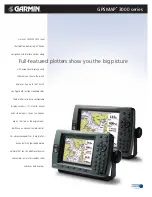
104
Track:
A Track is a series of saved points that define the past path of the boat. These Track
Points are saved at regular time intervals. Tracks are a useful and quick method to see
where you’ve been, and an easy guide to follow to get you back to the starting point.
Generally, all GPS units have a limited number of Track Points that can be saved before
the unit runs out of memory and begins erasing the first track points saved. Because of
this, the user can adjust the Track Point Interval menu to increase the amount of time
between when points are saved, and thus extend the distance covered by a track. Tracks
can also be permanently saved to memory, and re-displayed at the user’s option.
Track Line (TRK):
The Track Line is the desired line of travel between two waypoints, and
represents the most efficient path between the two points because it is a straight line.
The TRK is measured in degrees (i.e. 321°, where 000° is North, 090° East, 180° is South,
270° is West). See
Cross Track Error
,
Course Over Ground
.
Trackplotter:
Trackplotter describes a navigation device that shows Present Position,
along with Track, Waypoint, and Routes, but NO MAP in the background. See
Chartplotter
.
Trolling Grid:
Trolling Grid is a Humminbird® feature that displays a precise reference
grid around a waypoint. This grid is used as a guide pattern for trolling around a specific
area to assure a more efficient and complete coverage of that area. Trolling Grid
resolution be changed by zooming in or out on the chart. The Trolling Grid can also be
rotated on the display to orient it for optimal boat course for wave and wind conditions.
UTC:
UTC is an acronym for Universal Time Constant. UTC is the “standard time” used in
navigation, and is the local time in Greenwich England. (UTC is equivalent to Greenwich
Mean Time (GMT)). To display the correct Local Time in a Humminbird® GPS unit, the
user must use the Local Time Zone menu and select the time zone (i.e. EST, CST).
WAAS:
WAAS is an acronym for Wide Area Augmentation System. WAAS is
complementary technology to GPS that provides enhanced accuracy through correction
signals broadcast from Federal Aviation Administration WAAS satellites stationed over
the USA. These secondary signals are automatically received by the standard
Humminbird® GPS Receiver. With WAAS signal, GPS accuracy is improved to within 3
meters 95% of the time. Outside the United States, regional governmental coalitions
have created similar systems such as EGNOS (Europe) and MSAS (Japan).
Waypoint:
A Waypoint is the saved location (latitude, longitude) of a point of interest
that is stored in a GPS receiver’s memory. This can include a marker buoy, dock, fishing
103
Magnetic North. Humminbird® GPS units provide the option of selecting True or
Magnetic readouts by using the North Reference menu. See
Magnetic North.
Present Position:
Present Position is the current location (latitude, longitude)
determined by GPS. The Present Position is indicated on-screen by a directional boat icon
if the boat is moving, or a round symbol if the boat is stationary.
Route:
A Route is series of waypoints linked together in a specific sequence to define
a navigation path between two points, and saved in the fishfinder’s memory. Routes
are often used when frequently traveling between two or more locations because it
is a faster and more accurate method than repeatedly selecting individual waypoints
each time one travels through the same area. Routes consist of a Start Waypoint, an
End Waypoint, and a series of waypoints in between. Users can begin navigation at
the beginning, the end (to run the route in reverse) or at any waypoint in between.
See
Waypoint
.
SD:
SD is an acronym for Secure Digital. An SD card is virtually identical in function to an
MMC; however, the speed at which information can be accessed is generally faster, the
storage capacity is generally larger, and the card has security features which can be used
to prevent extracting the data from the card. SD is the same format that many digital
cameras use. See
MMC
.
Selective Availability:
Selective Availability (SA) is a GPS system “feature” that can be
implemented by the U.S. Department of Defense (DoD) to degrade the accuracy of GPS
positioning information. With SA active, the GPS is accurate to within 100 meters 95%
of the time. With SA inactive, the GPS is accurate to within 45 meters 95% of the time.
Currently, SA is inactive and the consumer can enjoy the greater precision GPS provides;
however, the DoD reserves the right to activate SA at any time.
Speed Over Ground (SOG):
Speed Over Ground is the measurement of the boat’s
progress across a given distance, and is the speed measurement provided by GPS. An
alternate, Speed Through Water, is provided by a speed paddlewheel, and is the
measurement of the flow past the boat, which may vary depending on current speed
and direction. Speed Over Ground is optimal for navigation because accurate
destination times can be derived from this measurement. Humminbird® products allow
for input and display of both speed measurements.
Time To Go (TTG):
Time To Go is the estimated time required to reach the destination
waypoint. TTG is calculated using the SOG and DTG. See
SOG
and
DTG
.
531450-1_A - 383c_Eng.qxd 11/18/2005 2:38 PM Page 110

































